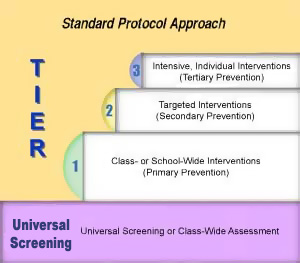What is RTI?
Page 1: A Quick Overview of RTI
 Contrary to what many people believe, for most children learning to read is not effortless. Many factors affect students’ abilities to learn how to read and can affect reading success in the early grades. Some factors affecting reading success include:
Contrary to what many people believe, for most children learning to read is not effortless. Many factors affect students’ abilities to learn how to read and can affect reading success in the early grades. Some factors affecting reading success include:
- Exposure to early literacy activities
- Quality of childcare and preschool programs
- English-language proficiency
- Parents’ income
- Quality of reading instruction
Typically, students who struggle with reading in the early grades will struggle in all academic areas. This is so because the curriculum in the upper grades relies more and more on independent reading skills. Because of this, it is important to assess and remediate reading skills when students are young.
 Of course, it is sometimes difficult to determine exactly which specific reading skills a student lacks. Understanding and recognizing the differences that exist between successful and struggling readers is an important step for teachers who hope to positively influence their students’ reading.
Of course, it is sometimes difficult to determine exactly which specific reading skills a student lacks. Understanding and recognizing the differences that exist between successful and struggling readers is an important step for teachers who hope to positively influence their students’ reading.
Response to intervention (RTI) aims to identify struggling students before they fall too far behind their peers. RTI is also offered as an alternative to the IQ-achievement discrepancy model for identifying students with learning disabilities. Furthermore, RTI is a prevention approach that can be used with any academic area. There are a number of advantages to implementing this approach. For instance, RTI:
- Provides multiple levels of interventions
- Increases the use of research-validated practices in the core classroom instruction
x
research-validated practice
A strategy or practice that has been proven to work through experimental research studies or large-scale research field studies. Referred to by a variety of terms, such as scientifically based practices and evidence-based instruction.
- Provides instructional intervention early to those who need it
- Relies on assessment data to support instructional decisions
- Reduces inappropriate special education placements
Because the majority of available research about RTI focuses on reading in the early grades, this module focuses on how the RTI approach is applied to reading in grades K–3. The box below highlights a few key points of this research.
Research Shows
- RTI is a systematic way to provide timely and effective support to struggling students.
(National Joint Committee on Learning Disabilities, 2005) - Implementing research-validated, instructional reading approaches reduces the number of students who need special education services.
(Foorman, 2003)
Components of RTI
Although there are several approaches to RTI, the term as used in this module refers to the standard protocol approach (sometimes referred to as standard treatment protocol) because the S-Team members at Rosa Parks have decided to use this particular approach at their school. This module continues their story. RTI consists of the following components:
standard protocol approach
An RTI approach that uses a validated intervention (selected by the school at Tier 2) to improve the academic skills of its struggling students; an alternative to the problem solving approach, which individualizes instruction at Tier 2. Sometimes also referred to as the standard treatment protocol approach.
- Universal screening: Screening assessment administered to all students in the class
- Tier 1: Class- or school-wide interventions
- Tier 2: Targeted interventions
- Tier 3: Intensive, individualized interventions

Universal Screening or Class-Wide Assessment. Universal screenings are used to identify students’ current levels of academic achievement. Students whose achievement is less than desired are identified.
Tier 1: Class- or School-Wide Interventions (Primary Prevention). All students receive high-quality classroom instruction using empirically validated techniques. Students receive frequent progress monitoring of academic skills, and those who do not meet desired benchmarks become eligible for Tier 2 services.
empirically validated
Condition or characteristic of having been proven through high-quality research to be accurate or to produce positive results.
Tier 2: Targeted Interventions (Secondary Prevention). The standard protocol provides all students receiving Tier 2 with the same, empirically validated intervention. This intervention is often provided in a small-group setting for a set period (anywhere between 10–20 weeks), with frequent progress monitoring. Students within the small groups may possess heterogeneous or homogeneous skills. Typically, the validated standard protocol includes instruction in several sets of skills so that each child’s needs can be met, even with heterogeneous grouping. For example, a small group might include one student who has problems with reading fluency, another who has poor phonemic awareness, and another who has difficulties with phonics skills. The intervention the group members receive is the same, with time devoted to each skill area (e.g., phonemic awareness, phonics, vocabulary, reading fluency, and comprehension).
Tier 3: Intensive, Individualized Interventions (Tertiary Prevention). State and district policies determine the options at Tier 3. In one of these, students who still do not make adequate progress with Tier 2 intervention can receive more intensive interventions. In another option, students receive special education services if abbreviated or comprehensive evaluation results verify the existence of a disability.
A more detailed explanation of the overall RTI process and the standard protocol approach, can be found in the following IRIS Module:
The subsequent pages of this module include information on the importance of using a comprehensive core reading program and high-quality instructional practices when implementing the RTI approach.